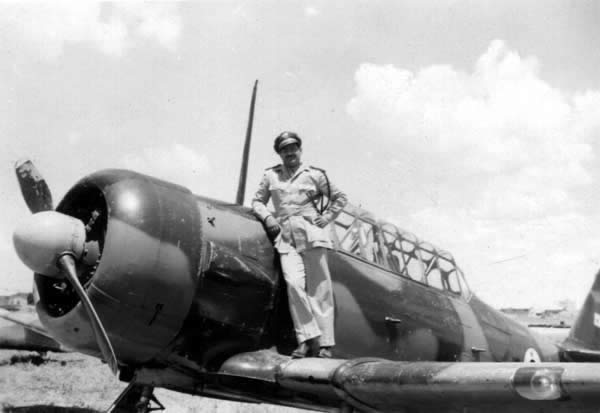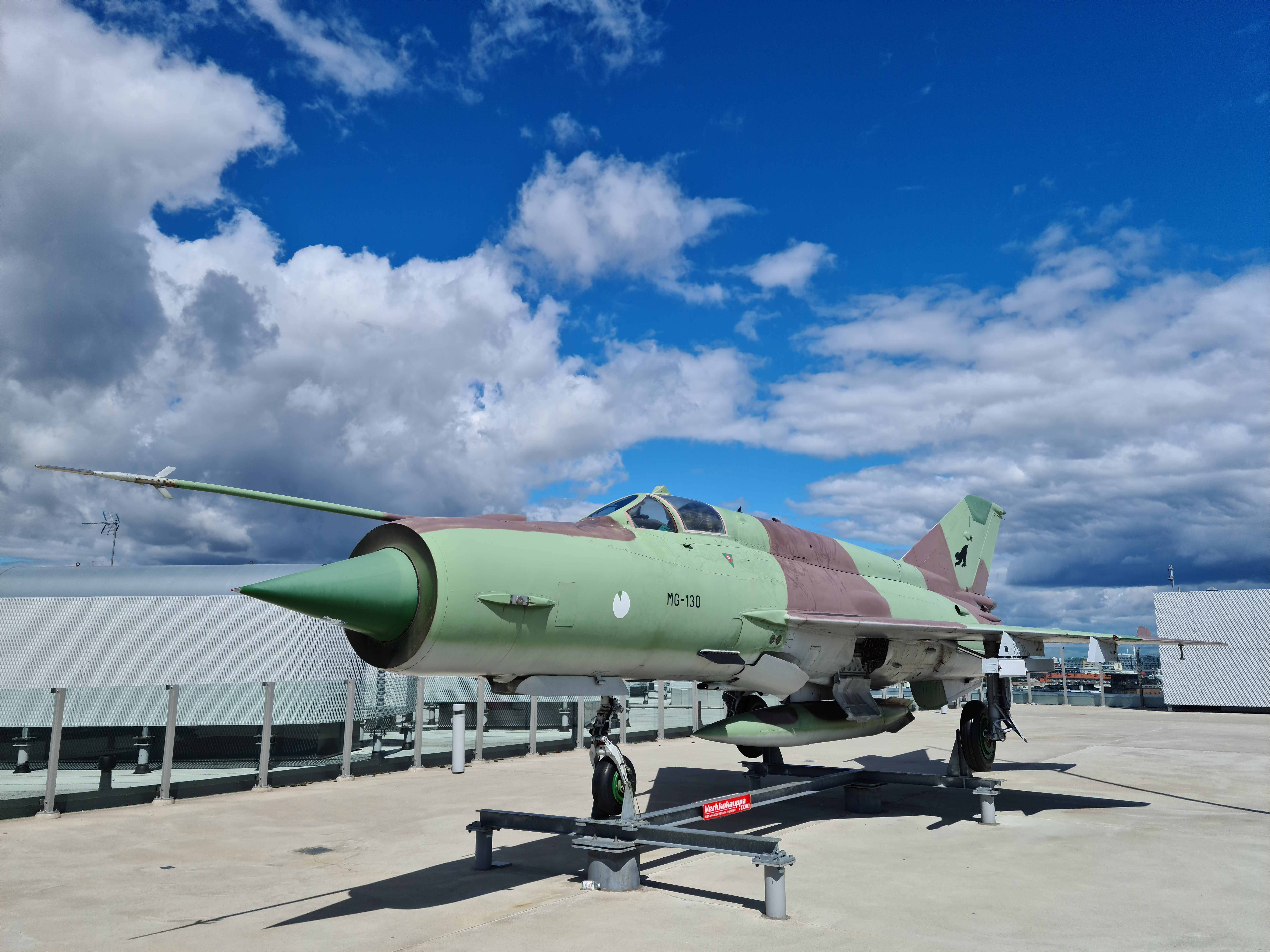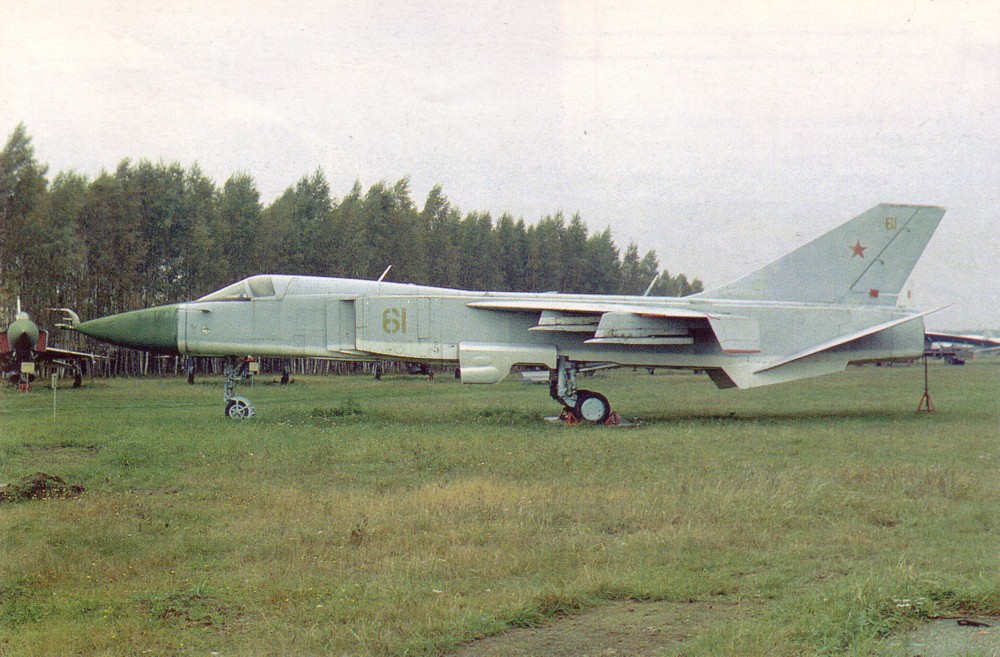|
Syrian Arab Air Force
The Syrian Air Force () is the air force branch of the Syrian Armed Forces. It was established in 1948, and first saw action in the 1948 Arab–Israeli War. Under Ba'athist Syria until December 8, 2024, it was known as the Syrian Arab Air Force. Land-based air defense systems were grouped under the Syrian Air Defence Force, which split from both the Air Force and the Army. As of March 2025, the air force status is unknown, with some of its equipment being lost following the Hay'at Tahrir al-Sham and other rebel groups offensive in November 2024 and subsequent Israeli Air Force's airstrikes in December 2024, following the collapse of the Assad regime. History 1940s The end of World War II led to the withdrawal of the United Kingdom and France from the Middle East, and this included a withdrawal from Syria. In 1948, the Syrian Air Force was officially established after the first class of pilots graduated from a French-run flight school at Estabel airfield in Lebanon, using ... [...More Info...] [...Related Items...] OR: [Wikipedia] [Google] [Baidu] |
Air Force
An air force in the broadest sense is the national military branch that primarily conducts aerial warfare. More specifically, it is the branch of a nation's armed services that is responsible for aerial warfare as distinct from an army aviation or naval aviation units. Typically, air forces are responsible for air supremacy, gaining control of the air, carrying out Strategic bombing, strategic and tactical bombing missions, and providing support to land forces, land and naval forces often in the form of aerial reconnaissance and close air support. The term air force may also refer to a tactical air force or numbered air force, which is an operational formation either within a national air force or comprising several air components from allied nations. Air forces typically consist of a combination of fighter aircraft, fighters, bombers, Military helicopter, helicopters, Military transport aircraft, transport planes and other aircraft. Many air forces may command and control ot ... [...More Info...] [...Related Items...] OR: [Wikipedia] [Google] [Baidu] |
MiG-21
The Mikoyan-Gurevich MiG-21 (; NATO reporting name: Fishbed) is a supersonic jet aircraft, jet fighter aircraft, fighter and interceptor aircraft, designed by the Mikoyan, Mikoyan-Gurevich OKB, Design Bureau in the Soviet Union. Its nicknames include: "''Balalaika''", because its planform (aeronautics), planform resembles the balalaika, stringed musical instrument of the same name; "''Ołówek''", Polish language, Polish for "pencil", due to the shape of its fuselage, and "''Én Bạc''", meaning "silver swallow", in Vietnamese language, Vietnamese. Approximately 60 countries across four continents have flown the MiG-21, and it still serves many nations seven decades after its maiden flight. It set aviation records, becoming List of most-produced aircraft, the most-produced supersonic jet aircraft in aviation history, the most-produced combat aircraft since the Korean War and, previously, the longest production run of any combat aircraft. Development Origins The MiG-21 jet figh ... [...More Info...] [...Related Items...] OR: [Wikipedia] [Google] [Baidu] |
Su-24
The Sukhoi Su-24 (NATO reporting name: Fencer) is a supersonic, night fighter, all-weather tactical bomber developed in the Soviet Union. The aircraft has a variable-sweep wing, Twinjet, twin engines and a side-by-side seating arrangement for its crew of two. It was the first of the USSR's aircraft to carry an integrated digital Nav/attack system, navigation/attack system. The Su-24 started development in the early 1960s and first flew in 1967. It entered service in 1974 and production ceased in 1993. It remains in service with the Russian Aerospace Forces, Syrian Air Force, Ukrainian Air Force, Algerian Air Force and various other air forces to which it was exported. Development Background One of the conditions for accepting the Sukhoi Su-7, Sukhoi Su-7B into service in 1961 was the requirement for Sukhoi to develop an all-weather variant capable of precision air strikes. Preliminary investigations with ''S-28'' and ''S-32'' aircraft revealed that the basic Su-7 design was to ... [...More Info...] [...Related Items...] OR: [Wikipedia] [Google] [Baidu] |
Su-22
The Sukhoi Su-17 (''izdeliye'' S-32; NATO reporting name: Fitter) is a variable-sweep wing fighter-bomber developed for the Soviet Union, Soviet military. Developed from the Sukhoi Su-7, the Su-17 was the first variable-sweep wing aircraft to enter Soviet service and featured updated avionics. The aircraft also has variants which were designed to be exported to non-Soviet states such as the Sukhoi Su-22 and the less popular Su-20. It was produced from 1967 to 1990. The Su-17/20/22 series had a long career and has been operated by many air forces, including those of the Russia, Russian Federation, former Soviet republics, former Warsaw Pact, countries in the Arab world, Angola, and Peru. The Russian Federation retired its fleet in 1998. Although the Su-17 was capable of carrying nuclear weapons, it was used in roles ranging from close-air support to ground attack. Development Shortly after the Su-7 fighter-bomber was put into service, the Sukhoi Design Bureau was ordered to dev ... [...More Info...] [...Related Items...] OR: [Wikipedia] [Google] [Baidu] |
Fin Flash
Military aircraft insignia are insignia applied to military aircraft to visually identify the nation or branch of military service to which the aircraft belong. Many insignia are in the form of a circular roundel or modified roundel; other shapes such as stars, crosses, squares, or triangles are also used. Insignia are often displayed on the sides of the fuselage, the upper and lower surfaces of the wings, as well as on the fin or rudder of an aircraft, although considerable variation can be found amongst different air arms and within specific air arms over time. History France The first use of national insignia on military aircraft was before the First World War by the French ''Aéronautique Militaire'', which mandated the application of roundels in 1912. The chosen design was the French national cockade, which consisted of a blue-white-red emblem, going outwards from centre to rim, mirroring the colours of the French flag. In addition, aircraft rudders were painted ... [...More Info...] [...Related Items...] OR: [Wikipedia] [Google] [Baidu] |
Flag Of The Syrian Revolution
A flag is a piece of textile, fabric (most often rectangular) with distinctive colours and design. It is used as a symbol, a signalling device, or for decoration. The term ''flag'' is also used to refer to the graphic design employed, and flags have evolved into a general tool for rudimentary signalling and identification, especially in environments where communication is challenging (such as the Maritime flag, maritime environment, where Flag semaphore, semaphore is used). Many flags fall into groups of similar designs called flag families. The study of flags is known as "vexillology" from the Latin , meaning "flag" or "banner". National flags are patriotic symbols with widely varied interpretations that often include strong military associations because of their original and ongoing use for that purpose. Flags are also used in messaging, advertising, or for decorative purposes. Some military units are called "flags" after their use of flags. A ''flag'' (Arabic: ) is equival ... [...More Info...] [...Related Items...] OR: [Wikipedia] [Google] [Baidu] |
Military Aircraft Insignia
Military aircraft insignia are insignia applied to military aircraft to visually identify the nation or branch of military service to which the aircraft belong. Many insignia are in the form of a circular roundel or modified roundel; other shapes such as stars, crosses, squares, or triangles are also used. Insignia are often displayed on the sides of the fuselage, the upper and lower surfaces of the wings, as well as on the fin or rudder of an aircraft, although considerable variation can be found amongst different air arms and within specific air arms over time. History France The first use of national insignia on military aircraft was before the First World War by the French ''Aéronautique Militaire'', which mandated the application of roundels in 1912. The chosen design was the French national cockade, which consisted of a blue-white-red emblem, going outwards from centre to rim, mirroring the colours of the French flag. In addition, aircraft rudders were pain ... [...More Info...] [...Related Items...] OR: [Wikipedia] [Google] [Baidu] |
Roundel Of Syria (1948–1958; 1961–1963)
A roundel is a circular disc used as a symbol. The term is used in heraldry, but also commonly used to refer to a type of national insignia used on military aircraft, generally circular in shape and usually comprising concentric rings of different colours. Other symbols also often use round shapes. Heraldry In heraldry, a ''roundel'' is a circular charge. ''Roundels'' are among the oldest charges used in coats of arms, dating from at least the twelfth century. Roundels in British heraldry have different names depending on their tincture. Thus, while a roundel may be blazoned by its tincture, e.g., ''a roundel vert'' (literally "a roundel green"), it is more often described by a single word, in this case ''pomme'' (literally "apple", from the French) or, from the same origins, ''pomeis''—as in "Vert; on a cross Or five pomeis" (a green field with a golden/yellow cross on which are drawn five green roundels/circles). One special example of a named roundel is the fountain, dep ... [...More Info...] [...Related Items...] OR: [Wikipedia] [Google] [Baidu] |
Issam Hallaq
Issam Hallaq () is a senior Syrian Military Commander and former Chief of Air Force Staff during the Syrian Civil War. Hallaq had overall responsibility to the Chief of the General Staff The Chief of the General Staff (CGS) is a post in many armed forces (militaries), the head of the military staff. List * Chief of the General Staff (Abkhazia) * Chief of General Staff (Afghanistan) * Chief of the General Staff (Albania) * C ... for operations and activities of the Air Force. References Syrian generals Living people Year of birth missing (living people) Air force generals {{Syria-mil-bio-stub ... [...More Info...] [...Related Items...] OR: [Wikipedia] [Google] [Baidu] |
Muhammad Al-Khuli
Muhammad al-Khouli (; born 1937) is a Syrian former military officer who served as the chief of the Syrian Air Force and the director of the Air Force Intelligence Directorate throughout the presidency of Hafez al-Assad. Early life Al-Khouli was born in Beit Yashout in 1937 to an Alawite family descending from the Hadadeen tribe, near the coastal city of Jableh. Information on his early life is scarce, although it is known that he was not involved, nor interested, in the Ba'ath Party which took power in Syria in March 1963.Batatu, p. 1999, 242. Career Early service In 1964, al-Khouli was appointed Deputy Chief of the Syrian Air Force under Hafez al-Assad. When al-Assad ousted the government of Nureddin al-Atassi and Salah Jadid in 1970, he appointed al-Khuli Chief of Air Force Intelligence. Between 1971 and 1973 he underwent training in East Germany under both the GDR Air Force and the Stasi. Eventually, he gained the additional prominent position of Chairman of the President ... [...More Info...] [...Related Items...] OR: [Wikipedia] [Google] [Baidu] |
Hafez Al-Assad
Hafez al-Assad (6 October 193010 June 2000) was a Syrian politician and military officer who was the president of Syria from 1971 until Death and state funeral of Hafez al-Assad, his death in 2000. He was previously the Prime Minister of Syria, prime minister from 1970 to 1971 as well as the regional secretary of the Regional Command of the Arab Socialist Ba'ath Party – Syria Region, regional command of the Arab Socialist Ba'ath Party – Syria Region, Syrian regional branch of the Arab Socialist Ba'ath Party and secretary general of the Ba'ath Party (Syrian-dominated faction), National Command of the Ba'ath Party from 1970 to 2000. Assad was a key participant in the 1963 Syrian coup d'état, which brought the Syrian regional branch of the Arab Socialist Ba'ath Party to power in the country, a power that lasted until the Fall of the Assad regime, fall of the regime in 2024, then led by his son Bashar al-Assad, Bashar. After the 1963 coup, the new leadership appointed Assad as ... [...More Info...] [...Related Items...] OR: [Wikipedia] [Google] [Baidu] |







